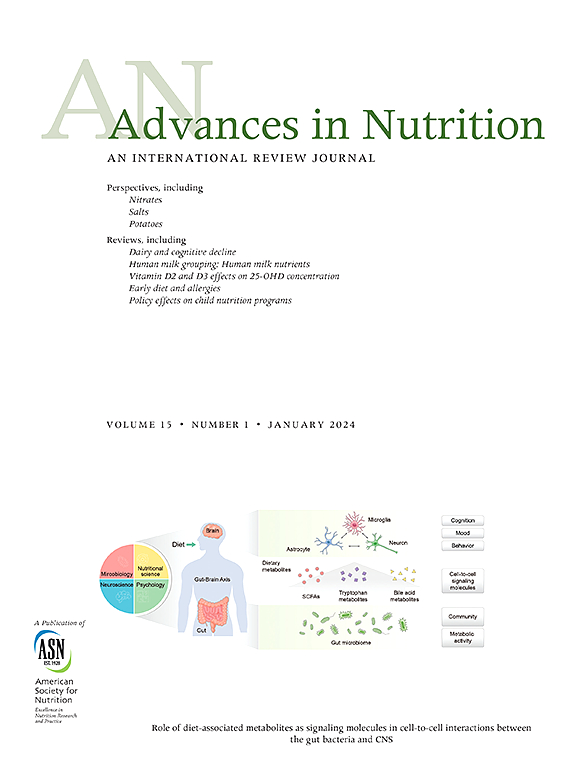膳食多不饱和脂肪酸与饱和脂肪酸的比值作为ldl -胆固醇反应的指标:随机临床试验的系统回顾和荟萃分析。
IF 9.2
1区 医学
Q1 NUTRITION & DIETETICS
引用次数: 0
摘要
背景:膳食指南建议通过用多不饱和脂肪(PUFA)代替饱和脂肪(SFA)来限制饱和脂肪(SFA)的摄入量。PUFA和SFA对低密度脂蛋白胆固醇(LDL-C)的影响相反,因此PUFA与SFA的膳食比例(P:S)可能比单独SFA更好地指示LDL-C反应。目的:对随机临床试验进行了系统回顾和荟萃分析,以检查健康成人对高P:S比饮食的LDL-C反应,并将其与等能、总脂肪匹配的低P:S比饮食进行比较。方法:系统检索PubMed、Cochrane Central和Web of Science。纳入持续≥3周的随机完全饲养试验,包括两种P:S比相差>.3的试验饲粮,能量、纤维和总脂肪匹配。采用随机效应荟萃分析评价高P:S比饮食与低P:S比饮食LDL-C的平均差异(MD)。试验饲料中SFA含量对P:S比影响的异质性也进行了评价。结果:共纳入1001篇文献,其中24篇文献报道了24项试验(n=1011)。高磷硫比饮食(中位数磷硫比1.2;PUFA 10.6%kcal; SFA 8.0%kcal; MUFA 12.6%kcal)比低磷硫比饮食(中位数磷硫比0.4;PUFA 4.4%kcal; SFA 12.5%kcal; MUFA 14.6%kcal)降低LDL-C (MD -9.84 mg/dL; 95%CI -13.65, -6.04; I2=79%)。当试验饲粮SFA含量不同(≥2%kcal)时,试验饲粮SFA含量(p2=68%)观察到P:S比效应的异质性,但当试验饲粮SFA匹配(MD -3.45 mg/dL; 95%CI -7.88, 0.98; I2=70%)时,试验饲粮SFA含量不存在异质性。结论:与低P:S比饮食相比,高P:S比饮食与一般健康成年人LDL-C的降低有关,当PUFA取代SFA时,这种效果更强。注册:前瞻性系统评价注册(PROSPERO)注册号:CRD42023452550。本文章由计算机程序翻译,如有差异,请以英文原文为准。
Dietary Polyunsaturated to Saturated Fatty Acid Ratio as an Indicator for LDL Cholesterol Response: A Systematic Review and Meta-Analysis of Randomized Clinical Trials
Background
Dietary guidelines recommend limiting saturated fatty acid (SFA) intake by replacing SFA with polyunsaturated fatty acid (PUFA). PUFA and SFA have opposing effects on low density lipoprotein (LDL) cholesterol, and therefore, the dietary ratio of PUFA to SFA (P:S) may be a better indicator of LDL cholesterol response than SFA alone.
Objectives
A systematic review and meta-analysis of randomized clinical trials was conducted to examine LDL cholesterol responses to higher P:S ratio diets compared with isoenergetic, total fat-matched diets with lower P:S ratios in healthy adults.
Methods
A systematic search of PubMed, Cochrane Central, and Web of Science was conducted. Randomized complete feeding trials lasting ≥3 wk, including 2 test diets with P:S ratios differing by >0.3 that were matched for energy, fiber, and total fat, were included. Random effects meta-analysis was used to evaluate the mean difference (MD) in LDL cholesterol with higher P:S ratio diets compared to lower P:S ratio diets. Heterogeneity in the effect of the P:S ratio by SFA content of the test diets was also evaluated.
Results
In total, 1001 publications were identified, and 24 publications reporting 24 trials (n = 1011) were eligible. Higher P:S ratio diets (median P:S ratio 1.2; PUFA 10.6% kcal; SFA 8.0% kcal; and MUFA 12.6% kcal) lowered LDL cholesterol [MD −9.83 mg/dL; 95% confidence interval (CI): −13.63, −6.04; I2 = 79%] compared with lower P:S ratio diets (median P:S ratio 0.4; PUFA 4.4% kcal; SFA 12.5% kcal; and MUFA 14.6% kcal). Heterogeneity in the P:S ratio effect was observed by the test diet SFA content (P < 0.001). Higher compared to lower P:S ratio diets lowered LDL cholesterol (MD −15.72 mg/dL; 95% CI: −20.51, −10.92; I2 = 68%) when the test diets differed in SFA (≥2% kcal), but not when diets were SFA-matched (MD −3.45 mg/dL; 95% CI: −7.88, 0.98; I2 = 70%).
Conclusions
Compared with lower P:S ratio diets, higher P:S ratio diets were associated with greater LDL cholesterol reductions in generally healthy adults, and this effect was stronger when PUFA replaced SFA.
This trial was registered at Prospective Register of Systematic Reviews (PROSPERO) as CRD42023452550.
求助全文
通过发布文献求助,成功后即可免费获取论文全文。
去求助
来源期刊

Advances in Nutrition
医学-营养学
CiteScore
17.40
自引率
2.20%
发文量
117
审稿时长
56 days
期刊介绍:
Advances in Nutrition (AN/Adv Nutr) publishes focused reviews on pivotal findings and recent research across all domains relevant to nutritional scientists and biomedical researchers. This encompasses nutrition-related research spanning biochemical, molecular, and genetic studies using experimental animal models, domestic animals, and human subjects. The journal also emphasizes clinical nutrition, epidemiology and public health, and nutrition education. Review articles concentrate on recent progress rather than broad historical developments.
In addition to review articles, AN includes Perspectives, Letters to the Editor, and supplements. Supplement proposals require pre-approval by the editor before submission. The journal features reports and position papers from the American Society for Nutrition, summaries of major government and foundation reports, and Nutrient Information briefs providing crucial details about dietary requirements, food sources, deficiencies, and other essential nutrient information. All submissions with scientific content undergo peer review by the Editors or their designees prior to acceptance for publication.
 求助内容:
求助内容: 应助结果提醒方式:
应助结果提醒方式:


